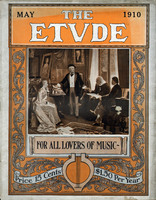Books have been written about the many-sided Franklin. His omnivorous and practical mind seemed ready to attack any new branch of science with the same earnestness. Music did not escape him, and he actually invented a musical instrument that was sufficiently unique to arouse the interest of some of the great masters.
How long “musical glasses” have been used for their special purposes no one really knows. There is an account of an Irish performer who played upon the musical glasses in his native country as early as 1743. When Gluck went to England (April, 1746), there is an account of his playing at the little Haymarket Theatre, with runs as follows: “He played a concerto on twenty-six drinking glasses, tuned with spring water, accompanied by the whole band, being a new instrument of his own invention, upon which he performs whatever may be done upon the violin or harpsichord.” In Goldsmith’s “Vicar of Wakefield” the “musical glasses” are mentioned as being fashionable.
When Franklin was in London (1762) he saw a performer upon the glasses, who played them by wetting his fingers and wiping them over the brims. Seeking to improve and systematize this instrument and, at the same time, to extend its usefulness by means of the application of mechanical appliances, Franklin devised an unusual looking instrument, which was described thus in Grove’s Dictionary: “The bells or basins of glass were ranged or strung on an iron spindle (long rod). The largest and deep-toned ones were at the left, and gradually rose in pitch, according to the usual scale. The lower edges of the basins were dipped in a trough of water. The spindle or rod was made to revolve before the performer, so that all the, glass bowls were kept continually going around and around by means of a treadle connected with the spindle and operated by the foot of the performer. The sound was produced by applying the fingers to the wet edges of the bowls as they revolved. Franklin called the instrument the ‘Armonica.’”
Mozart wrote music for this unusual musical machine, and it became very popular in parts of Germany. The composer Naumann wrote sonatas for it, and at one time it was used in some of the court orchestras. Beethoven wrote a piece of twenty-four measures for the instrument. In Germany the instrument was called the “harmonica.” Its tone was often irritating, penetrating and exciting, and it was said to have had a bad effect upon the nerves of the performers.



